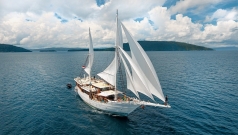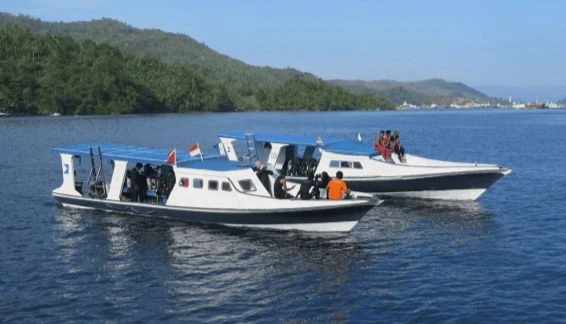Raja Ampat
One of the few destinations left which truly allows you to feel like you are a pioneer - to boldly dive where no man has dived before. You can marvel at the incredible topside scenery of West Papua, sail through waters where so few boats venture and experience some of the most impressive scuba diving in Indonesia ... and therefore the world. For those who want to get away from it all and dive in a remote paradise but not compromise on comfort then Raja Ampat liveaboards are the choice for you.
> [More details:
Raja Ampat]
Komodo National Park
The islands of myth and legend where dragons roam, are surrounded by rich nutrient-filled waters where a kaleidoscope of colour and life awaits scuba divers. Mantas, dolphins and sharks compete with critters galore, all against a riot of soft coral colours. Komodo liveaboard trips allow you to visit the many varied sites around this awesome marine park, some starting in Bali and visiting all the best sites along the way.
> [More details:
Komodo National Park]
Sulawesi
The island is home to some of the most varied and incredible diving in the world. To dive from Manado in the Bunaken National Marine Park means being surrounded by marine bio-diversity that is the envy of the world - with more varieties of coral than anywhere else. Ocean currents sweep nutrient rich water around Bunaken island meaning an abundance of marine life from tiny crustaceans to sharks and rays. Dive sites range from walls to reef flats to critter hunting in the sand. Bunaken is among the most rewarding and relaxing diving in Indonesia, suitable for all experience levels.
A short drive from here is the Lembeh Strait - the undisputed King of muck diving destinations. This small calm stretch of water is where macro-photographers and critter hunters agree offers the most impressive diving. Along the black sandy floor you will encounter more bizarre and fascinating marine creatures than you could wish for. This is why many divers return time and again to Sulawesi, an Indonesian island where you can fulfill all your dive dreams.
Banda Islands
The Banda Sea may be located between the better known destinations of Komodo and Raja Ampat, but for those in the know it deserves its own reputation as one of the world's best dive regions. Scuba diving in Banda means experiencing incredible variety of both large and small. Big pelagics and large schools abound. The reefs are healthy and thriving. Consider on top of this that many different species of whales and dolphins are often sighted, and you begin to get the picture. Diving here is varied, colourful and fascinating.
The Banda Sea is covers a huge area and the diving varies greatly from place to place. Many Banda Sea trips use the port of Ambon which is something of a macro haven. Here you can dive in Ambon Bay along the dark sandy floor beneath local fishing boats. Scraps are tossed into the sea from these boats making the waters a veritable banquet for all sorts of weird and wonderful critters. These include Ambon scorpionfish, fingered dragonets, thorny seahorses and multiple moray eel species - as many as 10 distinct species! There is much wonderful muck diving in Indonesia, and Ambon Bay is up there with the best.
> [More details:
Banda Islands]
Forgotten Islands
This is a diving region rising in reputation in eastern Indonesia, otherwise known as the south east Moluccas. This eastern section of the Banda Sea is often dived alongside Alor (to the south) or Raja Ampat (to the north). Few liveaboards venture here, so you will feel like a pioneer diving around islands like Wetar, Nila, Damar, Sermata and Tanimbar. There is often excellent visibility as you dive drop-offs, reef flats and pinnacles. Highlights include schools of hammerhead sharks (September to November), whale sharks, bumphead parrotfish, plus large schools of big-eye trevally and barracuda. There are also plenty of macro delights in the pristine reefs to keep you enthralled when the big pelagics are not in sight.
> [More details:
Forgotten Islands]
Triton Bay
Lying to the south east of Raja Ampat in Indonesian West Papua, Triton Bay is often included in those liveaboard safaris which include the Banda Sea and/or Raja Ampat. It is an excellent dive region in its own right with fabulous soft coral coverage, vast forests of black coral, big schools of fish, epaulette sharks, turtles, whale sharks, pilot whales and more. The topside scenery, with its vaulting cliffs, lush verdant foliage and ancient cave paintings, also contribute to it being a unique and unforgettable destination.
> [More details:
Triton Bay]
Cenderawasih Bay
Further northeast from Raja Ampat in West Papua lies the large and increasingly famous Cenderawasih Bay. It is best known for incredible scuba diving opportunities with large numbers of whale sharks. There are also several World War II wrecks to investigate and some top class muck diving locations with critters galore. Year upon year, as its reputation grows, more divers are experiencing the wonders of Cenderawasih.
> [More details:
Cenderawasih Bay]
Bali
Indonesia's most famous tourist resort island has plenty of options for scuba divers of all levels of experience. Deep walls, drift dives through deep water channels, coral reefs, volcanic muck diving, a world famous wreck, offshore islands, mola mola and mantas, superb island scenery and affordable prices. No wonder Bali remains a popular dive destination of choice for many.
> [More details:
Bali]
Alor
Moving east from Komodo you will find the islands of Alor and Flores which, together with other little surrounding islands form an excellent diving region. Less visited than some of its better known neighbours, Alor and Flores liveaboard trips promise some top quality Indonesian diving without the competition for space that can be seen elsewhere. Varied dive sites, superb macro-life, a low human population and excellent visibility make this a relatively undiscovered gem of a diving destination. Sharks, schooling fish, critters like pegasus and bobbit worms, plus underwater lava flows all contribute to this Indonesian dive experience.
> [More details:
Alor]
Sangalaki
This island and its neighbouring islands of Maratua, Kakaban and Derawan are a remote diving region off the east coast of Indonesian Borneo. More liveaboards have begun to visit the region in recent years attracted by the promise of manta rays, whale sharks, meaty pelagics, large schools of fish and pristine reefs. Add to this snorkelling in the jellyfish lake of Kakaban and some great macro sites, and it is clear why this up-and-coming region is viewed as a leading Indonesia diving destination.
> [More details:
Sangalaki]






































































